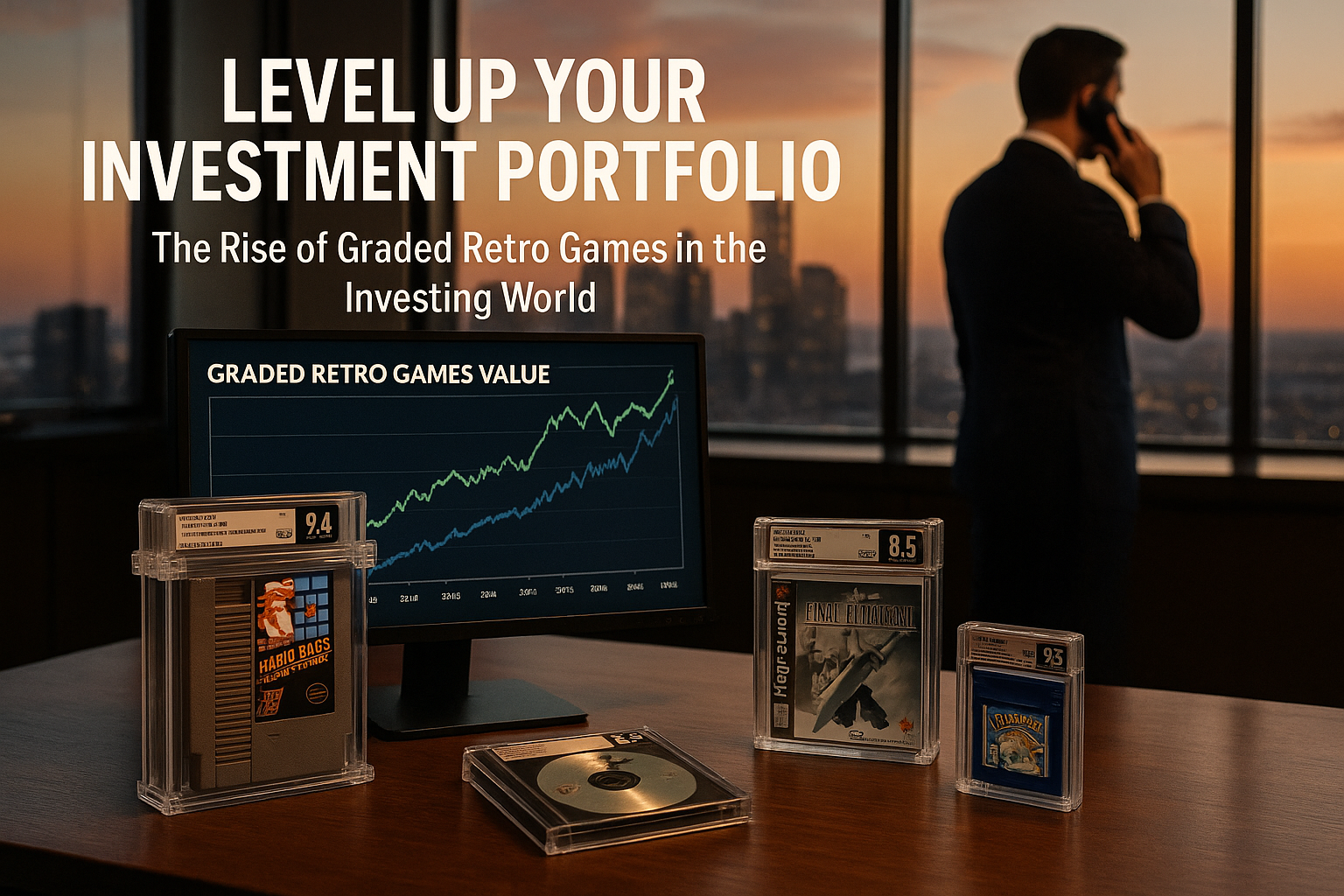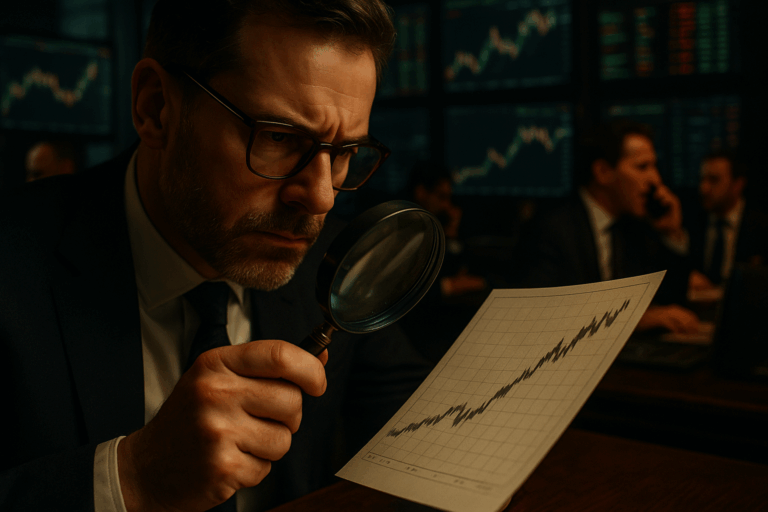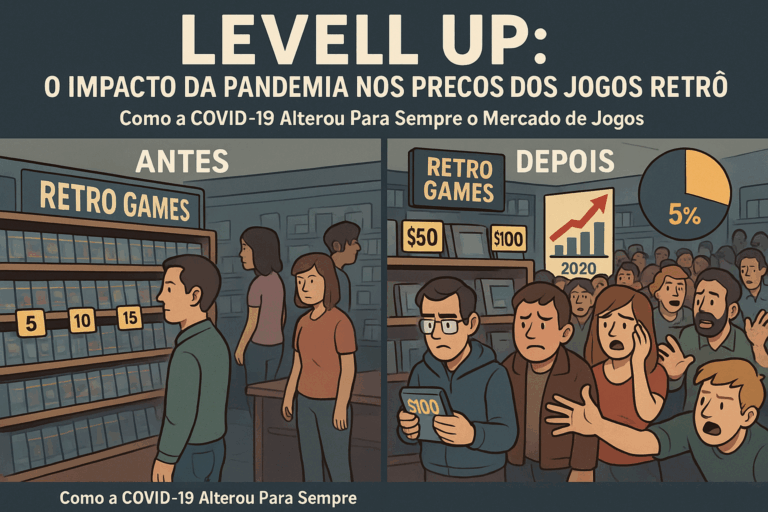In the world of investments, a common adage states, “diversify, diversify, diversify”. With the digital age upon us, we are witnessing an increasing diversification in the investment portfolio beyond traditional stocks, bonds, and real estate. An exciting and nostalgic addition to this array is the surge of graded retro games, a sector that has lately been drawing significant attention from collectors, gamers, and investors alike. This article will explore this rising trend, dissecting the ins and outs of graded retro game investment, elucidating its potential, and guiding you on how you can level up your own investment portfolio.
The past decade has seen a significant upsurge in the collectibles market. Be it comic books, baseball cards, or vintage toys, the interest in owning a piece of nostalgia has skyrocketed. Amid this expanding universe of collectibles, graded retro video games have carved a unique niche for themselves. These are not just pieces of plastic with circuits inside; they are time machines transporting us back to a simpler time, an era that laid the foundation for the sophisticated gaming industry we see today. This factor, coupled with their increasing rarity, has resulted in an astounding appreciation in value over the years. And that’s where the investment potential comes in.
Investing in graded retro games, however, is not as straightforward as it might appear. This market, like any other, is subject to factors such as scarcity, condition, market demand, and grading, to name a few. For the uninitiated, the concept of grading might be foreign. In the world of collectibles, grading refers to the process of professionally assessing the condition of an item. This grading is then encapsulated in a tamper-evident, protective plastic case, ensuring the item’s preservation. A higher grade indicates a better condition, leading to increased value.
Over the course of this article, we will delve deeper into these factors that influence the value of graded retro games. We will also provide practical advice on how to start investing in this sector, discuss the risks involved, and offer strategies for building a profitable graded game portfolio. Our journey will take us through a world filled with childhood memories and rare artifacts, a world where Super Mario and Sonic the Hedgehog are not just game characters, but profitable investment avenues. So, whether you are a serious investor seeking to diversify your portfolio, a casual gamer with a penchant for nostalgia, or a collector on the lookout for rare finds, this article will equip you with the necessary knowledge to navigate the exciting world of graded retro games. So, buckle up and get ready to level up your investment portfolio!
The Emergence of Graded Retro Games as an Investment
The financial landscape is in a constant state of evolution, with new asset classes emerging regularly. Among the newest entrants are graded retro games, vintage video games that have been professionally graded for their condition and authenticity. With the rise of nostalgia-driven markets, these games have begun to attract significant attention from investors. In fact, according to the NPD Group, the market for video game products continues to break records, setting the stage for increased interest in vintage game investments.
The appeal of these games lies in their rarity and sentimental value. For many, these games serve as tangible pieces of childhood and a reminder of simpler times. The grading process further enhances their value, with higher grades indicating better preservation and rarity. As demand for these games increases, so does their potential for a profitable return.
However, like any other investment, venturing into graded retro games requires thorough research and understanding. This article aims to provide a comprehensive overview of this unique investment class, discussing key aspects such as the grading process, market trends, and potential risks and rewards.
Understanding the Grading Process
The grading process for retro games is akin to that of collectible cards or coins. A professional grading company assesses the game’s condition and rarity, assigning it a grade that reflects its overall quality and value. The game is then sealed in an archival-quality case to preserve its condition.
The most well-known grading company in the industry is the Wata Games. They grade games on a scale of 1 to 10, with 10 representing a game in pristine condition. Factors considered during grading include the game’s physical condition, the condition of the box and manual (if included), and the game’s rarity. As a general rule, games that are still sealed in their original packaging receive the highest grades.
Understanding the grading scale is crucial for investors as it directly impacts the game’s market value. For example, a game graded at 9.0 or above is considered near-mint condition and will likely command a high price. On the other hand, games graded below 7.0 are typically seen as poor investments due to their lower demand.
Market Trends: Why Graded Retro Games are on the Rise
Over the past few years, the market for graded retro games has seen significant growth. This trend can be attributed to several factors, such as the rise of nostalgia-driven markets and the increased availability of grading services.
Nostalgia plays a significant role in the appeal of retro games. For many, these games provide a direct link to their past and the excitement of reliving childhood memories. This emotional connection, coupled with the games’ scarcity, creates a strong demand that drives their prices upward.
Another factor contributing to the market’s growth is the increased availability of professional grading services. Companies like Wata Games and VGA (Video Game Authority) provide collectors and investors with an objective assessment of a game’s condition and rarity, adding credibility to the market. The growth of these services has helped to standardize the market and attract more investors.
Investing in Graded Retro Games: Risks and Rewards
Like any investment, graded retro games come with their own set of risks and rewards. On the one hand, the strong demand and limited supply of these games can lead to substantial profits. For instance, a copy of “Super Mario Bros.” for the NES, graded at 9.6 by Wata Games, sold for a whopping $2 million in August 2021. This shows the immense potential for profit in this market.
However, the market is also highly volatile and subject to trends. What is popular today may not be tomorrow, leading to potential losses. Additionally, the grading process itself can be subjective, leading to inconsistencies in game values.
To mitigate these risks, investors should diversify their portfolio, research thoroughly before investing, and stay updated with market trends. A comprehensive understanding of the market and the factors that influence game values is essential for success in this investment class.
Comparing Graded Retro Games with Other Investments
| Investment Type | Advantages | Risks |
|---|---|---|
| Graded Retro Games | High potential for profit, nostalgia-driven demand, uniqueness. | High volatility, subject to trends, grading inconsistencies. |
| Stocks | Liquid, potential for dividends, easier to research. | Market volatility, potential for company to fail. |
| Real Estate | Steady income through rent, potential for appreciation, tax benefits. | High initial investment, management costs, market fluctuations. |
A Closer Look at a Few Iconic Retro Games
To better understand the appeal of investing in graded retro games, let’s take a closer look at a few iconic examples. This should provide a clearer picture of why these games have gained such traction in the investment world.
- Super Mario Bros. (NES): As mentioned earlier, a sealed copy of this game, graded at 9.6 by Wata Games, sold for $2 million in 2021. As the first game in the massively popular Mario franchise, it holds immense nostalgic value and is highly sought after by collectors.
- The Legend of Zelda (NES): Another classic from Nintendo, The Legend of Zelda is a beloved franchise with a dedicated fanbase. In 2021, a sealed copy of the game, graded at 9.0 by Wata Games, sold for $870,000.
- Pokémon Red and Blue (Game Boy): The Pokémon franchise has a massive global following, making these games a potentially profitable investment. In 2020, a sealed copy of Pokémon Red, graded at 9.8 by Wata Games, sold for $84,000.
Where to Buy and Sell Graded Retro Games
Investing in graded retro games requires access to a reliable marketplace. Some of the most popular platforms include Heritage Auctions, eBay, and ComicConnect. These platforms provide a wide range of games to choose from and cater to both buyers and sellers. However, it’s essential to do your due diligence and thoroughly research any game before investing.
For those interested in the grading process, companies like Wata Games and VGA offer professional grading services. They also provide detailed guidelines on their grading process, which can be a valuable resource for both new and experienced investors.
Finally, online forums and communities like Reddit’s r/gamecollecting can be excellent sources of information and advice. Engaging with these communities can help you stay updated with market trends and gain insights from fellow collectors and investors.
Learning More About Graded Retro Games as an Investment
If you’re interested in learning more about graded retro games as an investment, I recommend watching the YouTube video “Are Retro Video Games Worth Investing In?” by Filthy Casuals. They provide a deep dive into the world of retro game investing, discussing key factors to consider and sharing their personal experiences.
So, if you’re looking for a unique and exciting investment opportunity, graded retro games may be worth considering. With a bit of research and a keen eye for quality, you could find yourself owning a piece of gaming history – and possibly a profitable investment.
Remember, as with any investment, there are risks involved. So do your homework, stay informed, and never invest more than you’re willing to lose. Happy investing!

Conclusion
In summary, the world of graded retro games as an investment avenue is as exciting as it is intricate. This emerging asset class, fueled by a combination of nostalgia and rarity, offers the potential for high returns. From the record-breaking sales of “Super Mario Bros.” to the enduring appeal of “The Legend of Zelda,” these tangible pieces of childhood bring a unique blend of sentimentality and monetary value.
The grading process is a vital aspect of this market, providing an objective assessment of a game’s condition, rarity, and overall value. Companies like Wata Games and VGA have been instrumental in standardizing this process, adding credibility to the market and attracting a wider array of investors. However, it’s essential to understand the grading scale and its impact on a game’s market value, as it can significantly influence investment returns.
The market trends indicate a robust growth trajectory for graded retro games. The combination of nostalgia-driven demand, scarcity, and the growing accessibility of professional grading services have contributed to the market’s expansion. Yet, investors should be aware of the inherent volatility and trend-driven nature of the market. Staying updated with market trends and conducting thorough research before investing are vital steps in mitigating potential risks.
In comparison to traditional investment types like stocks or real estate, graded retro games offer a unique blend of advantages and risks. Their high profit potential, driven by nostalgia and uniqueness, needs to be balanced against their volatility and the potential inconsistencies in grading.
The appeal of iconic retro games like “Super Mario Bros.,” “The Legend of Zelda,” and “Pokémon Red and Blue” underscores the potential of this investment class. The staggering prices these games have fetched in recent auctions reflect their immense nostalgic value and the profitability that can be achieved.
Marketplaces like Heritage Auctions, eBay, and ComicConnect offer platforms for buying and selling graded retro games. While they provide a vast selection, due diligence and thorough research are crucial before making any investment. Online communities like Reddit’s r/gamecollecting can offer invaluable advice and insights to both novice and experienced investors.
To gain a deeper understanding of this market, resources like the YouTube video “Are Retro Video Games Worth Investing In?” by Filthy Casuals can be immensely helpful. The video provides a detailed exploration of the retro game investing landscape, highlighting key factors to consider and sharing personal experiences.
In conclusion, the world of graded retro games offers a unique and compelling investment opportunity. It combines a nostalgic trip down memory lane with the potential for profitable returns. But, as with any investment, it comes with risks. So arm yourself with knowledge, keep abreast of market trends, and never invest more than you’re willing to lose.
The journey into the world of graded retro games can be as exciting as the games themselves. If you’ve found this article useful, feel free to share it with fellow enthusiasts, comment on your experiences, or apply what you’ve learned to your investment strategy. 🎮💰🚀 Remember, every great adventure starts with the first step. Happy investing!
Note: This article does not provide financial advice. Always do your own research and consult a financial advisor before making investment decisions.
Reference:
1. NPD Group
2. Wata Games
3. VGA
5. CNN
8. eBay
9. ComicConnect



